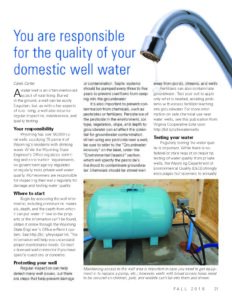We can all agree that the quality of your drinking water is very important. If you are on municipal water or are served by a water district, the water is already tested regularly. But if your water comes from a well or is hauled in and placed in a cistern then you should regularly test your water.
Testing your well water
Wyoming DEQ recommends sampling annually for a select list of constituents (bacteria and nitrate) and every 5 years for a comprehensive list of constituents. You should also test when:
- When there is an unexplained illness in the household,
- If there are changes to the taste, color, or odor of the water,
- If there are spills of chemicals or fuel near your well, or
- If your neighbors find contaminants in their well
The District offers cost share on well water testing for District members. Collection dates are offered in the spring and fall annually. See below for upcoming testing dates and information. The Annual Well Maintenance test tests for bacteria and nitrates, while the Domestic plus Bacteria test offers a more comprehensive test. Tests for livestock and irrigation suitability are also offered.
Well Siting and Maintenance
Homeowners are responsible for maintaining their water well and testing the water quality. This will help prevent contamination from getting into the groundwater. This includes not only properly locating your well site, but also maintaining the integrity of the well and protecting it from contamination. The Wyoming Department of Environmental Quality recommends homeowners test their water every other year.
For information on properly maintaining your well, see the article in the Barnyards and Backyards magazine: You are responsible for the quality of your domestic well water.

Do you haul water? Testing your cistern…
Whether hauling yourself or paying a hauling service, be sure to use clean water. It is also recommended that homeowners test the water from their cistern at least annually as well. An annual cleaning is also important to help remove sludge and sediment buildup. Also clean and test the water:
- When the water looks, smells, or tastes different than usual, and a test tells you it’s contaminated
- When contaminants—such as rodents or water from overland flooding—get in the cistern
- After the cistern is installed and sediment needs to be removed from the bottom of the tank
Tips on cleaning your cistern from My Health Alberta:
It is the homeowner’s responsibility to maintain their cistern the same as a private well, to ensure safe drinking water. The same tests for well water will also work to test the water from your cistern.
2024 Testing Important Dates
The District offers 2 testing dates annually, one in the spring and one in the fall.
- Spring Test Date: Tuesday, April 23rd – Deadline to order kit: April 10th
- Fall Test Date: Tuesday, October 22nd – Deadline to order kit: October 16th
Program Update:
For several years we have offered 3 different tests at a 70/30 cost-share and did not limit the number of tests per household. With the introduction of our new Lab Test Cost Share Program, we have decided to offer only the Annual Well Maintenance test on Well Water Testing Day. WCNRD will cover 100% of the cost of 20 Annual Well Maintenance tests per year, but it will now be limited to one test per household per calendar year on a first-come, first-served basis.
The Annual Well Maintenance tests for Anions, Conductivity, pH, Total Dissolved Solids, and Bacteria (coliform and E. Coli presence/absence).
Additional testing at a lab of your choice may be applied for through the Lab Test Cost Share Program.
TIMELINE
- Call or email to reserve your test kit at least 2 weeks before the testing day so kits can be ordered.
- Pick up test kits the week before the testing day
- On the testing day: collect your samples that morning and bring them to the District office by 10 am or to the Upton Town Hall by 11 am.
- Samples will be delivered to Energy Labs in Gillette, WY that day
Sampling Procedures
Please refer to these sampling instructions to ensure you collect an accurate sample: Collecting A Sample for Bacteriological Analysis
- The same procedure can be followed to fill all bottles provided in your test kit
Results
- If your sample tests positive for bacteria, you will be notified within 48 hours and provided next steps: Shock Chlorination Brochure
- Final test results will be sent out within about 3-4 weeks
Sample results interpretation
Well Educated: Understanding Your Test Results
Water Quality Interpretation Tool, courtesy of Colorado State Univers

